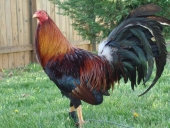Build the house far enough away they wont be a nuisance to you or your family but close enough to keep an eye on and easy walking distance for feeding and egg gathering,you may also locate the chicks door facing south so they can have a little sun shine in it for the winter months.
This is what i use for my fence
https://okbrandwire.com/agricultural-products/utility-fabric/
I make a four sided tunnel with this.I use the four feet tall by whatever length they have or i can afford at that time.I use this for garden fence too so its not just chicken wire.They do have two foot tall wire listed but my local farm store dont carry that,i may ask them to order some for me.For a 2' tall run.I guess you could just cut the 4' in half.I use the four foot for the chicks on parts that i need to get in to clean.Areas i dont worry about cleaning i use the 3' tall and build a triangle to save fence.
The fence supports its own weight,i just wire it together cutting and using the fence itself.The top is important to cover for hawks but around here it is the raccoons and possums we have to worry about just as much,this is why i make it a box or triangle to make sure they cannot dig under it.They cant scratch in it but they can eat grass and bug under and through it.I bought 17 chicks last spring and still have them all.You can make it as long as you can afford.You could also have smaller runs cutting off from the main one just by cutting a hole in the side of the main and attaching a new section to that.
I do let mine free range as well when im around.They are brown leghorns and blue andalusians.The leghorns are very flighty and extremely cautious of airborne assaults and will call and runn for cover if they see a bird of prey,thats run with two n.
Beautiful view you have there,love that country around there.My son just moved from Polaris MT last winter,we loved going to visit there.

 4
4




 5
5




 5
5




 4
4




 2
2




 2
2




 2
2




 2
2




 2
2










